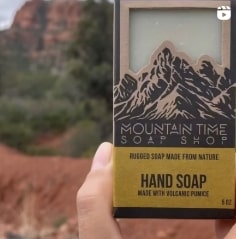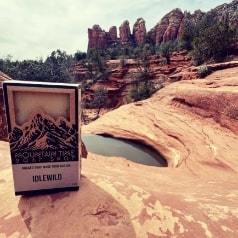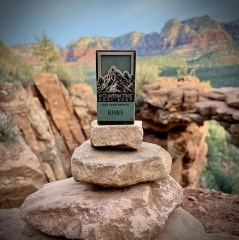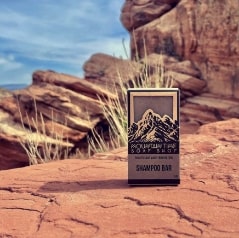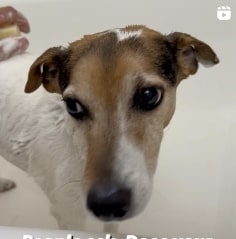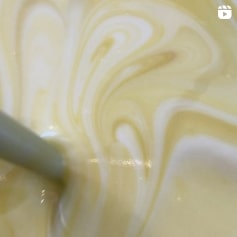It’s often during the beginning of a year that we decide to cast our bad habits aside. While we think you’re great, and likely don’t need to change, we know that sometimes change can be good. It brings about growth, happiness and leaves us feeling accomplished.
Heck, Mountain Time was started because Stacy wanted to see a change in the soap industry.
One resolution you could make is to try to abide by eco minimalist habits. Eco minimalism will free up your time and space, and it will give you the opportunity to protect the planet.
And, believe it or not, it’s not as hard as it may seem. You don’t even have to move into a tiny home. In fact, the first step is assessing what you have around you that might no longer be serving you.
Adopting even just a few eco minimalism habits can help reduce your carbon footprint and the clutter in your home.
What is Eco Minimalism?
Minimalism strives to create a life where you own less possessions. Ideally, these possessions would only be what you need or items that hold significant sentimental value. The founders of minimalism, Joshua Fields Milburn and Ryan Nicodemus, started minimalism as a way to become rich in experiences rather than things.
That said, minimalism means different things to different people. Some people want to take up less space in the world and downsize to an apartment. Some people want to apply minimalist practices to their mind so they meditate or remove apps from their phone. Some people declutter their home.
When you add “eco” to a minimalist title, you get a lifestyle where you consume less and are conscious of the waste you create. While some minimalists shop for quality products, minimalism doesn’t require you to consider how you dispose of the products. Being eco-friendly helps you consider the product's entire life cycle, including how to dispose of it, before making a purchase.
By practicing eco minimalism, you’ll train yourself to purchase only what you need while considering the full life cycle of the product.
The Benefits of Living an Eco Minimalist Lifestyle
One of the best parts about practicing eco minimalism is what you’ll actually end up saving.
- You’ll save time: You know where everything is. No more deep searches in multiple rooms for rogue items.
- You’ll save emotional energy: No more frantic searches at the last minute or tears over the inability to find something, either.
- You’ll save money: You know where your backup items are and you don’t need to buy more until you’re actually out.
- You’ll save the planet: Minimalism doesn’t buy into consumerism culture that necessitates more. Instead, it focuses on what you need. Being eco-friendly means considering a product’s full life cycle. While you only buy what you need, you’ll also only be buying what's good for the planet.
Stepping Into an Eco Minimalist Life by Decluttering
If you’re ready to take the plunge and live a more eco minimalist life, your first step is likely decluttering your spaces. You can declutter your home, your office, your car, your storage unit, your time and your mind. For this article we’ll focus on your home as this is one of the easiest places to start your decluttering journey.
Getting Started Decluttering Your Home
Who says decluttering can’t be fun?! We recommend doing things you enjoy while decluttering your space. Set the mood with your favorite candle. Play some music that fills you with joy. Pick up your favorite snack or, your favorite bottle of wine.
Avoid overwhelm by starting somewhere specific. Pick out one rack in your closet. Or, go through one item, like shoes. This will make the task feel more approachable.
Pull everything out of the space you’re decluttering, not just the stuff you know you don’t want. Seeing all your shoes together might make you question if you need three pairs of black tennis shoes. Once you’ve cleared the space, you can clean where the items were before putting them back.
Create piles based on the item’s next step. Here are our go to piles while decluttering:
- Put away: This is for your stuff that ends up somewhere weird. The pen on your shoe rack. The notebook in your underwear drawer. Take that object back to it’s home.
- Repair: Put anything that you’d like to repair or have repaired in this pile rather than leaving tucked away somewhere.
- Repurpose: This is for objects that you’d like to make into something else. Perhaps you have an old candle jar you’d like to boil the remaining wax out of and make a pen holder or a bobby pin container.
- Recycle: While you may picture piles of paper, cardboard boxes, or cans when we say recycling, there’s actually a lot more that can fit into this category. Many organizations will take specialty items, like old paint cans or polyester t-shirts. Do a little research before you declutter to become familiar with the recycling facilities around you.
- Donate: This is for everything you’re ready to part ways with but someone could likely still use. More to come on donating tips.
- Throw Away: While we’re not a big fan of waste, there’s often something we can’t fit into one of these categories that will go to landfills.
Once you start putting things back, organize items by use. Your go to’s should be the easiest to access.
At some point you may realize storage bins and organizers could help you keep from future clutter. Storage bins can make an area feel cleaner and create specific spots for items that may have been floating around your home. It’s important to consider what the bins and storage containers you’re buying are made of. Some sustainable materials include:
- Bamboo
- Palm leaves
- Water hyacinth fibers
- Recycled paperboard
- Holga grass
What Comes First, Decluttering or Cleaning?
Don’t make more work for yourself. Declutter before you clean. Some stuff won’t even need to be cleaned! And as you empty each space and sort items into piles, you’ll be able to clean all the hard to reach spots. Decluttering is the perfect time to give your home a deep clean.
Can’t Decide if You Should Keep Something or Not?
First, we recommend trying to remember these are material items. While we’d never want you to get rid of a sentimental piece, try and ask yourself the following questions:
- Do I have more than one of these?
- Is it my favorite?
- Is it the best one that I have?
- Have I used it in the last year?
If you have more than one, it’s not your favorite, it’s not the best one that you own or you haven’t used it in over a year, it might be time to part ways.
If you’re having a hard time getting rid of items, try to think of a specific person or organization to donate to. By picturing this group or individual, you’ll be able to let go of things you may have been holding onto. Like a winter jacket you no longer wear or jeans you grew out of. By focusing on that group of people you’ll likely be more generous and willing to give more away.
Once You’re in the Groove of Decluttering
If you’ve decluttered one space, give yourself a moment to feel proud of your accomplishment. When you’re ready, move onto the next space or group of items.
Find a “home” for the things you are keeping. Every item should have a it’s own spot to return to. Put items where they go when you’re finished with them. If this feels like too much for your entire home, start with a drawer or your closet. When you’re ready, take on the room it's in, then the rest of the house.
Now that you know the items in your home inside and out, start making sustainable swaps. Take note of all the plastic or single use items. Each time something runs out, find a sustainable alternative. You could swap out laundry detergent jugs for laundry detergent strips (which take up far less space in your home!) You could swap out single use q-tips for a reusable q-tip. Or, you could stop buying plastic soap products and substitute them with Mountain Time Soap products!
Things Not to Do When Decluttering
Here are some tips to ensure your decluttering, and eco minimalist lifestyle changes are successful:
- Don’t try to do it all at once. Set a realistic timeframe to make the changes. This can help your habit stick!
- Don’t buy storage or organizing items (like bins and dividers) until you’re done decluttering. You never know what you’re going to find in a weird spot later on.
- Don’t declutter once and never do it again. Decluttering is a habit, try and declutter once a season to once a month. This will help keep your home in order.
- Don’t miss out on great tips from the professionals! There’s a handful of people who have made decluttering and minimalism their life. They likely have great insight for your new eco minimalism journey!
- Marie Kondo
- Empty Box Method
- Use the 90/90 rule
- The 10% method
- Utilize the Tape method
- Create a time capsule wardrobe
- Don’t throw it all away! This is where the eco in eco minimalist comes in! If items are useful but you don’t want to keep or repurpose them, consider finding a new home for them. Some great options are
- Poshmark: A space to sell your clothes online
- Facebook Marketplace: Rehome items with your neighbors
- Happy Beetle: This is one of our favorite waste diversion organizations in Denver
- Freecycle: Like Facebook Marketplace, post items for your neighbors to buy or pick up
- Ridwell: An organization that collects hard to recycle items
- Search for organizations around you
Tips for Living an Eco Minimalist Life after Decluttering
Decluttering is the first step in your eco minimalist lifestyle. The next is making conscious purchasing decisions, as well as the following tips.
Switch to online payments and say goodbye to paper clutter! This will require you to manage your inbox, but you’ll be creating less waste and minimizing your carbon footprint.
When it’s a gift giving season (we’re looking at you Valentine’s Day, birthdays, and Christmas) and someone asks you what you want, tell them! Consider asking for an experience gift, like a cooking class, a museum pass, or a gift card to your gym. If you want a physical item, send them the link to what you want, or give them specific details. This will help you avoid getting a gift you don’t want.
During the 2021 holiday season, more than half a trillion dollars was spent in the US alone on gifts. Roughly $500 billion of those gifts are returned and will end up in landfills. Sometimes, climate advocacy is being honest about what you want in a gift.
Have a heart to heart with the loved one who gets you things you don’t need. Tell them you love that they’re so thoughtful, but ask them to check with you before making a purchase. Or, consider encouraging to buy consumable gifts, like homemade salsa, a seed card, or a bar of Mountain Time Soap.
Limit what you bring home. Try to not buy kitchen appliances that don’t have multiple uses. Buy wardrobe items that you can wear with pieces you already own. Try to donate or repurpose something every time you buy something new. Or, you can set a spending limit for new “things”. We’re also super impressed with people who pledge not to buy anything for extended periods of time.
Making Living an Eco Minimalist Lifestyle a Habit that Sticks in 2022
It’s inevitable that eventually, you will need or want something. That’s ok! What’s important is considering if you actually want something, or if you’re making an impulse buy. Next, you’ll want to consider if purchasing it will create environmental harm you’d like to avoid.
Even if you don’t live by eco minimalism practices, consider the following questions before you buy anything.
- How was this made?
- What did it take for it to get here?
- Is it a consumable item that won’t create waste?
- Will I still love it in a year or will it be in style?
- What kind of packaging did it come in?
- Can I repair it or repurpose it when I’m finished with it?
- How do I dispose of it at the end of its life cycle?
By examining our spending habits, and using eco minimalist principles as a guide, we can make more conscious purchasing decisions in 2022.
Author - Kelcie Ottoes







